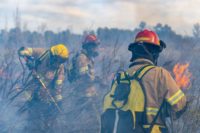Source: www.firefighternation.com
U.S. Rep. Richard L. Hanna, [R-NY-22], has introduced a bill (H. R. 4625), legislation that would "require the Secretary of Health and Human Services to develop a voluntary patient registry to collect data on cancer incidence among firefighters."
The bill, introduced on Feb. 25, has 11 co-sponsors. It was referred to the Committee on Energy and Commerce.
A copy of the full-text of the legislation follows: To require the Secretary of Health and Human Services to develop a voluntary patient registry to collect data on cancer incidence among firefighters.
Be it enacted by the Senate and House of Representatives of the United States of America in Congress assembled,
SECTION 1. SHORT TITLE.
This Act may be cited as the 'Firefighter Cancer Registry Act of 2016'.
SEC. 2. FINDINGS.
Congress finds the following:
(1) Studies conducted since the 1990s have indicated a strong link between firefighting and an increased risk for several major cancers.
(2) The cancers identified as most common among firefighters according to these studies include testicular cancer, which male firefighters are 102 percent more likely to be diagnosed with, stomach cancer, multiple myeloma, and brain cancer, among several others.
(3) The heightened incidence of cancer among firefighters has been attributed to their frequent exposure to a range of harmful substances including resultant pyrolysis products, toxic particulates, gases and fumes, metals such as cadmium and lead, chemical substances such as benzene and vinyl chloride, and minerals such as asbestos and silicates.
(4) An extensive 2014 study conducted by the National Institute of Occupational Safety and Health (NIOSH) over the course of several years and which included almost 30,000 firefighters found that firefighters were at an increased risk of being diagnosed with malignant mesothelioma and found potential links between exposure to fire incidents and heightened risks for lung cancer and leukemia, among several others.
(5) Past studies examining cancer incidence among firefighters have been limited by the availability and standardization of important epidemiological data, relatively small sample sizes, inconsistencies in the operationalization of key terms and metrics, incomplete employment histories, and an underrepresentation of minority, female, and volunteer firefighters.
(6) Today, many States across the country maintain cancer registries that collect and collate information regarding cancer diagnoses, demographic information, and treatment plans. State cancer registries have greatly contributed to overcoming these obstacles by offering centralized repositories of information, which researchers in the public and private sectors can access when conducting research on cancer risks.
(7) While these State-based cancer registries undoubtedly contribute to furthering research related to assessing cancer incidence among firefighters, a special purpose national cancer registry would provide researchers and public health agencies with more direct and comprehensive access to the specific set of information they need to conduct more robust, focused, and epidemiologically rigorous research on cancer incidence among firefighters.
(8) Efforts to understand cancer incidence among firefighters through a specialized national cancer registry will better inform the kinds of precautions firefighters should take in the future, improve our understanding of key epidemiological trends, and potentially lead to the development of more sophisticated safety protocols to lower cancer risks.
SEC. 3. PATIENT REGISTRY FOR FIREFIGHTER CANCER INCIDENCE.
(a) In General- The Secretary of Health and Human Services, acting through the Director of the Centers for Disease Control and Prevention, shall develop and maintain a voluntary patient registry to collect data on cancer incidence among firefighters.
(b) Use of Registry- The patient registry shall be used for the following purposes:
(1) To establish and improve collection infrastructure and activities related to the nationwide monitoring of the incidence of cancer among firefighters.
(2) To collect, consolidate, store, and make publicly available epidemiological information related to cancer incidence and trends among firefighters.
(c) Relevant Data- In carrying out the voluntary data collection for purposes of inclusion under the patient registry under subsection (a), the Secretary should seek to include the following de-identified information:
(1) With respect to cancer diagnoses and treatment of firefighters, de-identified information on--
(A) full detailing of physical examinations and medical history;
(B) complete detailing of all relevant diagnostic tests and lab procedures;
(C) complete detailing of all pathology and operative reports; and
(D) complete detailing of treatments undergone or planned.
(2) With respect to individual patient history relating to the incidence of cancer among firefighters, de-identified information on--
(A) basic demographic information, including the age of the firefighter involved and age of onset of cancer;
(B) a listing of status of the firefighter as either volunteer, paid-on-call, or career firefighter;
(C) the number of years on the job and a detailing of additional employment experience that was either performed concurrently alongside firefighting service or anytime thereafter;
(D)(i) a measure of the number of fire incidents attended as well as the type of fire incidents (such as residential house fire or commercial fire); or
(ii) in the case of a firefighter who is unable to provide information on such number and type, an estimate of such number and type based on the method developed under subsection (d)(2); and
(E) a list of additional risk factors, including smoking or drug use, as determined relevant by the Secretary.
(3) Any additional information that is deemed necessary by the Secretary.
(d) Methods-
(1) IN GENERAL- For the purposes described in subsection (b), the Secretary is authorized to incorporate questions into public health surveys, questionnaires, and other databases in existence as of the date of enactment of this Act.
(2) ENSURING REPRESENTATION OF UNDERREPRESENTED GROUPS IN REGISTRY- In carrying out this section, the Secretary shall take such measures as the Secretary deems appropriate to encourage the inclusion of data on minority, female, and volunteer firefighters in the registry established under this section.
(3) METHOD TO ESTIMATE NUMBER AND TYPE OF FIRE INCIDENTS- For purposes of subsection (c)(2)(D), the Secretary, in consultation with the experts described in subsection
(e), shall develop a reliable and standardized method for estimating the number of fire incidents attended by a firefighter as well as the type of fire incident so attended in the case such firefighter is unable to provide such information.
(e) Consultation- The Secretary shall, on a regular basis, seek feedback regarding the utility of the registry established under this section and ways the registry can be improved from non-Federal experts in the following areas:
(1) Public health experts with experience in developing and maintaining cancer registries.
(2) Epidemiologists with experience in studying cancer incidence.
(3) Clinicians with experience in diagnosing and treating cancer incidence.
(4) Active and retired volunteer, paid-on-call, and career firefighters as well as relevant national fire and emergency response organizations.
(f) Research Availability- The Secretary shall develop and make public an approval process for making de-identified cancer registry data submitted for inclusion in the patient registry developed under subsection (a) available without a fee for public research purposes. Such process shall provide that such data shall be made available for such research purposes only if there is an agreement to make findings, journal articles, or other print or web-based publications derived from such research public or available to the relevant stakeholders identified in subsection (e)(4).
(g) Privacy- In carrying out this Act, the Secretary shall apply to the registry developed under subsection (a) data security provisions and privacy standards that comply with the best practices of the Centers for Disease Control and Prevention, as defined by the National Institute of Standards and Technology in Special Publication 800-37 revision 1, as well as the HIPAA privacy regulation, as defined in section 1180(b)(3) of the Social Security Act (42 U.S.C. 1320d-9(b)(3)).
(h) Authorization of Funds- To carry out this section, there are authorized to be appropriated $2,500,000 for each of the fiscal years 2017 through 2021.





